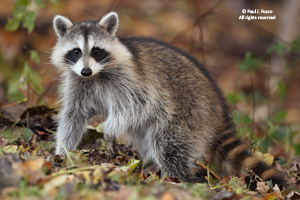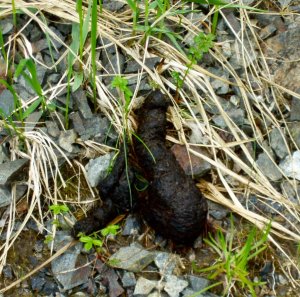January in the garden can be quite boring. Annuals are gone, and perennials and trees are dormant waiting for warmer weather. Still, I need to go outside and survey the once life-filled areas, even when they are brown, just to check on things. It is during this time of frozen ground and monotone palette that one can see what normally would be obscured and not noticed. Easily seen now, especially on top of snow, is scat, it is the excrement of animals; their poop. Yes, this article is about animal poop and how to identify which animal dropped it.
Scat is a sign left by other visitors to your garden. The purpose of scat is elimination and to mark the animal’s territory. It could be a predator animal such as fox and coyote that eat smaller animals like rabbits, voles and chipmunks which have the potential to be a pest in your garden. In this case, predator scat would be a welcome find. Domestic cats and dogs might leave their ‘offerings’ in areas in which you would be digging where you might come in contact with worm parasites and diseases that could infect humans. Take a shovel and remove dog and cat droppings to the garbage.
As a horticulturist at the UConn Home Garden Education Center, the public brings us plant and insect samples for identification and disease diagnosis. On occasion we have also been brought what the client called ‘crap in a bag’, and asked ‘what shat that?’ That fact being revealed, I still love my job. The observation, dissection and research of scat have led me to share this questionably valuable information here.
As a safety warning, never handle droppings to prevent disease and parasites. Wear gloves and a mask if dissecting, and use tools that can be disinfected after. Clean and disinfect microscope if using. Dissecting scat will tell us the diet of the animal. Many seeds will pass through the digestive tract intact and still be very identifiably. Grass eaters will have bits of undigested straw and fiber strands throughout the scat. Bits of fur and bones tell us the animal that produced the scat was a predator of other animals.
Before breaking apart the pieces of scat, identify the shape. Is it a sphere or a cylinder? Spherical, round and pellet-like, scat comes mainly from herbivores, plant eaters. These include rabbit, shrew, mouse, chipmunk, red and grey squirrel, which will be on the smaller size. Deer and moose will be larger pellets.
Round and slightly flattened spheres are made by rabbits.
Elongated small spheres are made by chipmunk, gray squirrel, mouse, red squirrel and shrew.
Cylinder shaped scat are primarily from carnivores, mostly meat eaters. They can be pointed, blunt, broken or twisted. All of these characteristics can help to identify the creator of the scat.Scat color can vary greatly among the same species making it not a great help, unless the scat is white. White scat comes from birds and reptiles.
Larger pellets or spheres are made by deer and moose.
Pointed cylinders come from fox, coyote and domesticated dogs.
Broken cylinders are left by bobcat and domesticated cats.
Twisted cylinders are from members of the weasel family; mink, marten, fisher and weasel. These will have hair and pieces of bone in them.
Blunt cylinders will be from raccoon or bear. They vary greatly depending on the time of year and the food sources available. Bear scat usually contains lots of seeds, including berries and nuts.
Opossum and skunk scat are rarely found, and can be quite varied in shape. Rather than finding these two’s scat, you will smell their musky scent in areas they have visited, and find signs of digging in the soil.
Earthworms leave castings on top of the soil during the night. These are a rich source of nutrients and beneficial to the garden.
If identifying animal waste to tell who is spending time in your garden is not to your liking, look for the footprints they leave and identify the tracks.
-Carol Quish




























July 7, 2017 at 4:14 am
[…] so encourage Ringtails to move on. They, like any wild animal, can transfer disease through their scat or urine. It is a great mouser if you are more concerned about mouse damage than the Ringtail […]
August 4, 2017 at 12:55 am
This is the best aid in identifying scat that I have found. Thank you.
July 21, 2019 at 8:56 pm
Thanks for a very helpful article. From this it is very clear that we have been getting visited by a raccoon.
August 10, 2020 at 12:25 am
Mushy, bright green, noticed no seeds;
My dog found it in my fenced back yard a couple of times. Have seen no wildlife but birds.
(Several years ago there were rats.)
I have flowers, grass & veges.